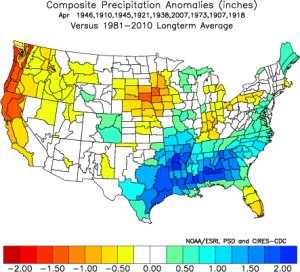This week’s U.S. Drought Monitor noted a region considered “Abnormally Dry” across central Illinois. This is a result of three things: below-normal precipitation over the last 90 days, much above-normal temperatures (which have increased evaporation), and streamflows that are much below-normal for this time of year. On that last point, streams are normally bank-full and then some, so being much below-normal still means there is water flowing.
At this point, there have been no significant negative impacts reported. In the short-term, the warm, dry weather is beneficial for field work. However, it is an area that we will watch in the future.



What Follows a Warm March?
What follows a warm March in Illinois? Out of curiosity I looked at the other nine years in the list of 10 warmest months of March on record in Illinois (earlier post). First, I looked at the temperature and precipitation patterns for April. Then I looked at the May-August period as the heart of the growing season. Here are the results.
Disclaimer: while past years can give some insight on how the atmosphere has behaved over Illinois, they are not always the best forecast for the upcoming month, season, or year. Each new year brings a unique set of circumstances that causes things to play out differently than any previous year.
April
Historically, a warm March has been followed by a colder-than-normal April on average (first map). That’s true not just in Illinois but across the U.S. On the other hand, precipitation for those same April periods was a mixed bag in Illinois (second map). Most of the state was near-normal while west-central Illinois was slightly wetter-than-normal. It is interesting that dryness shows up in Minnesota, Iowa, Nebraska, and South Dakota – an area having trouble with drought this year.


May – August
The period from May through August is the core of the growing season in Illinois. Rather than produce temperature and precipitation maps of each month, I considered the entire May-August period in one set of maps. One popular question I get is “Does this warm weather now mean that we will get a hot summer?” At least historically, the growing season following a warm March does not show a pattern of above-normal temperatures. On average, they have been remarkably mild in temperature. There is a tendency towards below-normal precipitation across much of Illinois and the Midwest. It’s nothing catastrophic, on average just an inch below normal in parts of eastern and northern Illinois. Meanwhile, southern Illinois is in an area of slightly above-normal precipitation.


One last note, using an average of several years together may cover up any kind of bipolar personality where half the summers were extremely hot and half the summers were extremely cold. I did not seeing anything like that in this analysis. For example, in the nine cases of the growing season temperatures, four were slightly cooler than normal, two were near normal, two cases slightly warmer than normal, and only one case (1921) was well above normal (i.e., hot).
Searching for March Records
If you are interested in daily and monthly weather records, there are a few excellent web sites that can help.
NOAA National Climatic Data Center
The NCDC site http://www.ncdc.noaa.gov/extremes/records/ allows you to look at daily, monthly, and all-time records for sites in a selected state. Records include temperature (highest high, lowest low, etc.), precipitation, and snowfall. The report for March is especially interesting with 352 broken records and 52 tied records for sites in Illinois as of March 27. See the link to the PDF below:
Report from NCDC on record highs set in March 2012
Weather Underground
The folks at weatherunderground.com has a similar page as the NCDC site with slightly different interface and output at http://www.wunderground.com/climate/extremes.asp.
On Track for Record Setting March
March
[updated March 30, 2012]
Based on data through March 29, the statewide average temperature was 54.7 degrees, 14.1 degrees above normal. Of course, we still have March 30-31 to go but all indications are that the much above normal temperatures will continue. So here are the ten warmest March’s in the Illinois statewide records that date back to 1895:
- 2012: 54.7°F (as of March 29)
- 1946: 51.6°F
- 1910: 50.9°F
- 1945: 50.5°F
- 1921: 49.1°F
- 1938: 48.1°F
- 2007: 47.6°F
- 1973: 47.5°F
- 1907: 47.0°F
- 1918: 46.4°F
January-March
Here are the ten warmest January-March’s in the Illinois statewide records. In this case, 2012’s hold on first place is more tenuous. Here you will notice that the 2000s are on the list three times as are the 1990s.
- 2012: 40.8°F (as of March 29)
- 1921: 39.2°F
- 1990: 38.7°F
- 1946: 38.1°F
- 1938: 37.6°F
- 1998: 37.3°F
- 1992: 36.9°F
- 2006: 36.7°F
- 2000: 36.7°F
- 1973: 35.9°F

